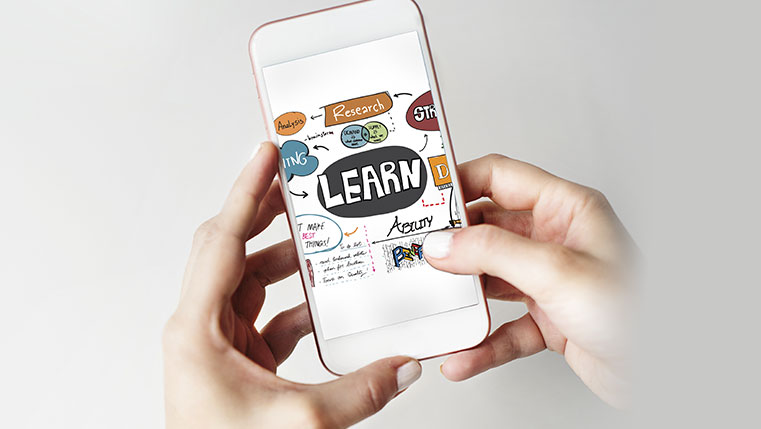Get the First Step of Mobile Learning Right – Pay Attention to Design Elements

Mobile devices have not only revolutionized the way we communicate but also the way we learn. Smartphones and tablets are being increasingly used for delivering mobile learning courses. The just-in-time aspect of mobile learning makes it a popular choice for learners and organizations. According to a report by Ambient Insight, mobile learning is the fastest developing learning technology. It is no wonder that organizations are rethinking their training programs and designing courses especially for mobile devices.
Designing mobile learning courses requires a different approach because you get only one-fourth of screen space in a mobile compared to a regular desktop. This means adopting a different design approach for your mobile courses.
Mobile learning design requires familiarity with the medium. An awareness of the capabilities and limitations of the mobile medium can help in the design process. For instance, factors such as the network speed and storage space will help determine the size of your mobile learning modules and the elements you can include in the course. Also consider the fact that learners will access the content on the go, so it has to be succinct and to the point and the graphics have to be eye-catching.
Instructional Design Elements to Consider
Scale to the size of the mobile screen
Before you start designing the storyboard, remember that the mobile device offers limited screen estate. Knowing the dimensions will give you a fair idea of how much content and other elements you can actually fit in the screen. It will help you better visualize how learning modules will appear on the mobile screen. However, with the evolution of adaptive and responsive design, it is now possible for learning designers to create a universal design that will cater to multiple mobile devices.
Chunk the content
The limited screen estate in mobile devices does not allow room for extensive content, so you will have to chunk the text to absolute essentials. Remove or cut down on introductions or discussions. You can break the content to fit multiple screens but ensure that the transition is logical.
In mobile learning, learners tend to scan the screen rather than read it, so place the most important information on the top and keep explanations brief. The key here is to ensure the content is short and engaging.
Use appropriate text size and font
The fonts and the text sizes you use on a mobile screen must be easily readable and striking so as to catch learners’ attention. The colors used on the screen should be attractive to the learner. Avoid the use of custom fonts because they can increase the load time.
Use interactivities suited to the mobile device
Since the device is hand-held, learners will be using their thumb or fingers to navigate the screen; consider interactivities such as multiple select, single select, or click on tabs that are conducive to users’ tactile navigation. Interactivities such as drag and drop or hotspots are difficult to operate on a touch screen and hovering the cursor over an image will not function on these devices.
Choose graphical and audio elements judiciously
The graphics used in the course must be connected to the text. Identification of an action or depiction of a state in illustrations can be best highlighted using popup text or caption labels. Avoid the use of illustrations or graphic elements that are not related to the course.
As for audio, use it judiciously. Textual content works well than narrated text in a mobile course because the learner may be in a situation where listening to audio may be difficult owing to background noise. So keep narration to a minimum and if you are using videos, provide the option to turn captions on and off.
Use designated spots for additional information or instructions
It is important to provide designated spots for accessing additional information or for providing information to learners to maintain uniformity across all screens in the course. The learner will intuitively know where to navigate for these elements. Also provide clear instructions to help the learner navigate through the course.
Replace content with infographics, videos, and animations
Content can be effectively replaced with well-designed infographics and animations that can explain the concept better to the learner. Videos are a worthy replacement for text, but ensure they are of short duration and have proper streaming. Ensure these elements are simple as complex ones will take a longer time to download.
Mobile learning design is very different from a regular e-learning course. The aspects to consider are the limited screen size, the way the learner will navigate the course, and where and how he will access it. These factors should determine your design. Get your mobile learning design to a good start by paying attention to the instructional design elements. What are the instructional design elements you consider when designing mobile learning? Let us know in the Comments section.


![Types of Visuals and Their Functions in E-learning [Infographic] Types of Visuals and Their Functions in E-learning [Infographic]](https://blog.commlabindia.com/hs-fs/hubfs/Imported_Blog_Media/types-of-visuals-in-elearning-infographic.jpg?width=670&height=1170&name=types-of-visuals-in-elearning-infographic.jpg)

![Mobile-First, Mobile-Friendly, Mobile-Only Courses: The Differences [Infographic]](https://blog.commlabindia.com/hubfs/Imported_Blog_Media/mobile-learning-courses-types.jpg)
![10 Tips to Design Mobile-Friendly Gamified Courses [Infographic]](https://blog.commlabindia.com/hubfs/Imported_Blog_Media/Tips-to-Design-Gamified-Mobile-Learning-Courses.jpg)
![6 Tips to Design Mobile-Friendly Gamified Courses [Infographic]](https://blog.commlabindia.com/hubfs/Imported_Blog_Media/gamification-mobile-learning-tips.jpg)